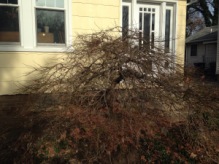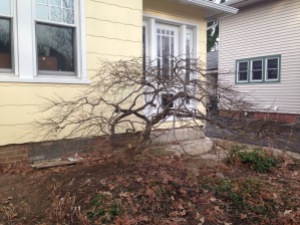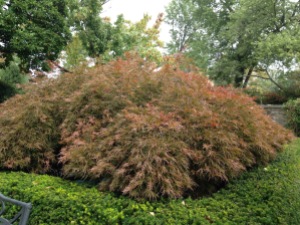
Removing Grass from Groundcovers
- So frustrating! Had a beautiful hill of vinca with tulips and crocus until the grass crept in. I kept thinking I would get to it, but after 3 years of procrastination, I decided to make this small 4×4 patch my priority this year.

- Because I am now serious and focused, I concentrate on my only two choices.
- OPTION 1: Use an herbicide labeled for grasses in ground covers. These can be effective, if applied at the right time and before the grass has become too invasive. My situation is past that.
- OPTION 2: Dig up clumps of grass and remove bare root vinca plants. As daunting as it sounds, I have to dive in to this option.
- Here is one grass-infested clump.

And this is one of several vinca plants with grass and grass roots removed 
After picture: Bare rooted plants are tucked in to grass-free soil just in time for the forecasted 3:00 rain to hit, perfect!

This process, on a 4×4 section took about 2 hours. I made a point to enjoy it. I took the rest of my life, the dogs, the emails, the dust bunnies, and put them on the front porch until I was done with this task. I knew they would still be there when I was satisfied. And I’m not delusional enough not to realize that there are still tiny tenacious grass roots in there, waiting for the chance to overtake again. However, this is my pet focus this year, to keep after intruders in this small space. It will be a game for me, and one I will win, because I love my yard.
Love your yard, it loves you back 10 times.
It’s Pruning Time!
Is everybody cozy?
To some, spending hours outside in below freezing temps may sound unappealing, but this is when I get excited! Every tree I see, I can’t help but imagine which limbs I would remove, how that will cause the tree to respond, and what I can get the tree to do for the greater good. That said, I apologize to people behind me at stoplights.
Here are some good reasons to prune now:
When plants are dormant, they don’t feel the stress of it like they do when they are pumping juices and making food. Also, you are not removing food producing leaves with every cut.
Pruning now prevents infestations of many insects and diseases that take advantage of open wounds during the growing season.
Seeing branch structure is easier with no leaves on the trees, and it’s easier to clean up. And because you’re all covered up, even sticky evergreens are fun to play with.
Here are some objectives to be achieved that you may not have thought of:
For a tight hedge that has become leggy, this is the best time to carefully prune to encourage fast regrowth of inside, and fluffy lower foliage.
Correction of unfortunate pruning mistakes made by well-meaning folks which cause the plant to misbehave, resulting in more maintenance and a plant that doesn’t live up to it’s full aesthetic potential, (in other words, is ugly)

Now, here is a 25 plus year old Japanese maple allowed to grow with little pruning, The owners loved the tree, but were afraid of making a wrong move. Her attachment to the tree (they had planted as a tiny investment when they bought the house) spurred her to call me.

Once the dead branches and limbs that were growing mischievously were removed, the majestic structure that is a Japanese maple, was allowed to fulfill its destiny.
Disclaimer alert! There are some trees and occasions that prefer summer pruning. Please be advised.
What Everyone Should Know About Planting A Tree
 There was a client who hired a reputable landscape company to plant a live screen between himself and his neighbors. Spruce were chosen for the spot and they looked great. But they died, one by one. The company came out and replaced them with more spruce, with the same result. Fortunately, the client asked around, then contacted a friend of mine who is known for his reputation of tree knowledge. The trees were planted in a swale, which is a low place in the property that collects water. Dave told the client he needed to plant to the swale.
There was a client who hired a reputable landscape company to plant a live screen between himself and his neighbors. Spruce were chosen for the spot and they looked great. But they died, one by one. The company came out and replaced them with more spruce, with the same result. Fortunately, the client asked around, then contacted a friend of mine who is known for his reputation of tree knowledge. The trees were planted in a swale, which is a low place in the property that collects water. Dave told the client he needed to plant to the swale.
“What does that mean?” he asked. Dave said, “Let’s plant something that likes the conditions in a swale.”
More important than size, appearance and growth habit, and what is often overlooked, is preferred growing conditions. Different plants have different needs, and when not met, the results are certain to be a disappointment, to say the least. A spruce will not tolerate wet feet for extended periods, while a bald cypress will love you for many years for putting it there. And while not fatal, siting a tri-color beech where it receives hot afternoon sun can turn its beautiful pink leaves’ margins to a “What’s wrong with my tree?” tan.
A tree planted in the wrong place will not maintain the qualities you selected it for. In other words, you are not getting what you wanted.
Yeah, we’re all in a hurry, we all want to save money, but fast-forward to 5 or 10 years from now. When you are looking at the plant that has not given you the shade you hoped for, or the flowers, fall color or screen you wanted, (fill in the blank here), what price would you put on having gotten it right in the first place?
The easiest way is to start with a professional who is passionate about what you want. Make sure what you choose is planted correctly by someone who is passionate about that. Then, nurture your investment by following the care instructions to make sure your perfect choice gets the love it needs to love you back like nobody’s business!
We can give you all that, plus referrals for others who are as passionate as we are.
So if you choose not to consult, at least consider doing this. Before making a final decision on a plant, go to your favorite search engine and type “Growing conditions for _______”. If you know the botanical name, it can weed out unuseful results. (Pun intended, as usual) Choose a source from a university or arboretum for the best information. If your planting site does not meet all of the criteria, keep looking.
We really do want you to be happy. The more people who are happy, makes the world a better place!
Makeover- Japanese Maple
This Japanese Maple looks heavy, like The Blob attempting to eat the formal boxwood hedge that has been assigned to contain it.

Weeping Japanese Maples are meant to look like they are wearing a beaded curtain, revealing the silhouette of the structure beneath unique to their species.
Often, homeowners never prune them for fear ruining them, or worse, hack them back in an effort to keep them small, leaving unsightly stubs, disfiguring and smothering their amazing potential.
The owner crawled under the canopy with me and we thoughtfully removed branches until it became a light cloud hovering delicately over the hedge.
Many mature plants can be reinvented with a little strategic pruning. Turn a crazy forsythia into a graceful small tree. That wild viburnum that is screening your neighbors’ junk pile can be tamed and still do it’s job while providing a habitat for wildlife. When pruned correctly, your overgrown plants can work for you instead of making more work. The possibilities are endless!
Want to learn how to prune your fruit trees?
 Now this is gratifying! Walking out in your yard to pick cherries to put on ice cream after dinner, or making peach cobbler without going to the store is a great way to celebrate summer!
Now this is gratifying! Walking out in your yard to pick cherries to put on ice cream after dinner, or making peach cobbler without going to the store is a great way to celebrate summer!
Growing fruit trees in Ohio does not have to be a mystery!
I love pruning fruit trees, for so many reasons. It breaks so many rules compared to pruning landscape trees. Knowing what every cut means to the tree is like being able to communicate with it. We can tell our fruit trees what we want them to do by the way we prune them!
Pest and disease control can be demystified organically with a little effort.
Even if you have inherited an overgrown apple, or have planted a peach tree five years ago that has grown crazy, we can get it all in balance, so you will be harvesting beautiful fruit for your family and friends.
Contact us for a consult!
Gift Ideas For Gardeners (My favorite tools!)
First, let me say that I am not getting any kickbacks for promoting these items! I simply want to share things that make my life easier.
I can’t list them in order of importance, because they are essential as far as I’m concerned.
A good tool belt.
 It holds so many of my favorite things. When I was a manager at Oakland Nursery, I ordered this brand for employees from Kaddy Products in Utah. Great folks, it’s a small family business that makes a durable product. http://www.kaddyproducts.com/ There are many color choices and all kinds of things geared to gardeners. No more walking back to the garage to fetch a tool, or worse, improvising with what you have in your hand, it’s all right there with you. When you are done in the garden, you hang it up, and it’s all ready for you the next time.
It holds so many of my favorite things. When I was a manager at Oakland Nursery, I ordered this brand for employees from Kaddy Products in Utah. Great folks, it’s a small family business that makes a durable product. http://www.kaddyproducts.com/ There are many color choices and all kinds of things geared to gardeners. No more walking back to the garage to fetch a tool, or worse, improvising with what you have in your hand, it’s all right there with you. When you are done in the garden, you hang it up, and it’s all ready for you the next time.
Tool belt contents:
Quality pruners: When they are sharp and feel good in your hand, you search for things to prune! This is one time to splurge. They will last a lifetime, and may become an heirloom.
A small folding saw: Nice because the moment you see a branch too big for pruners that needs to come off, you can spontaneously take care of it without going after your loppers.
A soil knife: Talk about multi-purpose! It plants annuals, digs weeds, cuts open a bag of mulch, cuts an edge along a sidewalk, and so many things that will fun figuring out yourself!
Plastic stretch tie tape: So many times I didn’t think I was going to need to tie something up, like tomatoes, a stray branch on a vine, etc. but because this is always with me, I am always ready. I like the stretchy plastic because you can tear it with your hands.

This is the coolest bud vase ever! A flower frog in the bottom of a beautiful piece of art supports something as small as single pansy, to sunflowers.  And this glass float has a hook for a weight to be attached so it will stay put in your pond where you want it. With a light weight, or no weight, your fish will have fun moving it around. Get them one for Christmas! The hook can also be used to hang the glass sphere from a tree or where ever else you want to add shiny color to cheer up the winter.
And this glass float has a hook for a weight to be attached so it will stay put in your pond where you want it. With a light weight, or no weight, your fish will have fun moving it around. Get them one for Christmas! The hook can also be used to hang the glass sphere from a tree or where ever else you want to add shiny color to cheer up the winter.
Contact the artist, Robert Coleman at ipunty@yahoo.com, or 740-393-4336.
Perfect, but cheap gloves: Gardeners tend to be frugal, not fancy. For less than $10, your gardener will be thankful for gloves that feel good, protect fingers from thorns, and still are flexible enough to let you feel and find the weeds that needs to be pulled fingers! Many brands and colors available, even tie-dye.
Gift cards gardeners will actually use and love you for:
Sharpening On Site- mobile sharpening service www.sharpeningonsite.com
Garden Stores- You can usually purchase online and have them shipped to you or your givee.
I’ll keep adding to this post, so come back!
The least you can do this fall for your plants is this…
The words ‘Fall Cleanup’ can sound overwhelming, so I want single out the things that, if you don’t do anything else, this list will make the biggest difference next year.
#1. Remove diseased plant debris! Removing foliage of tomatoes and peaonies, is the ounce of prevention you’re looking for. This step dramatically reduces disease and insect problems the following season. (However, keep in mind that leaving some debris from native plants will help preserve balance, but this is a topic for another post.)
#2 Soil Test. A soil analysis costs about the same as a bag of fertilizer, and will tell you how much of each nutrient to add. So much better than buying bags of stuff you don’t even need, and wasting an afternoon throwing it around. Get the right nutrients down now so it can get to work while you go in for the winter, eat soup and watch movies.
#3 Fertilize. Simply broadcast an organic fertilizer over your flower and vegetable beds, and around trees and shrubs. Good organic fertilizers containing humates help plants take in nutrients. Takes minutes, but they need it.
#4 Topdress your beds with compost. As the ground ‘breathes’ all winter and spring, it will help your plants absorb precious nutrients
That’s your bare minimum! If you get these things done, you can hibernate for the winter knowing that your garden is working toward a great spring and summer!
If you could smell the color blue, what would it smell like?
The blue I’m talking about is cobalt blue, but brighter, just a little lighter. And then, what if you could taste it?
 Last Spring, I saw Blue Spice Basil for the first time, (at Oakland Nursery). I read the name on the tag, then when I crushed a leaf, I could not get over the unusual, berry-basil fragrance. To me, it smells like the color blue. It does not smell like blueberries, just the color blue. Not to be confused with African Blue Basil, which is darker and spicier, this basil smells clear and round.
Last Spring, I saw Blue Spice Basil for the first time, (at Oakland Nursery). I read the name on the tag, then when I crushed a leaf, I could not get over the unusual, berry-basil fragrance. To me, it smells like the color blue. It does not smell like blueberries, just the color blue. Not to be confused with African Blue Basil, which is darker and spicier, this basil smells clear and round.
It tastes like its fragrance, the leaves in a salad lend and pleasant unexpected lift every few bites. I would love this stuff, even if I was only allowed to breath it in.
Tonight as I harvest the last of my basils because the nights are getting cool, I’m thinking about mixing it with some sweet basil, rose water and walnuts to make a pesto. I’m looking forward to trying it in an Indian dish. Would love to throw this ingredient in a cooking show to see what they pair it with!
Just wanted to give you something to look forward to:)
Want to Save $$$ on your Water Bill?
My spouse calls me the ‘Water Nazi’. Everyone has something they tend to be passionate about (ok, compulsive), and wasted water is mine. Gardeners know that effective watering the first year after planting is essential to the success of their plants. After all the grumbling I heard from clients last year about water bills, I am offering some of my favorite watering tips.
The most important thing to remember is to slow the water down. The slower it moves, the more of it gets absorbed where you want it, and no water will be wasted by running off.
The most obvious way, is to slow the water flow from your hose to a trickle or slow stream. Let it run for a spell while you pull weeds, or set a timer and do something else.
 My favorite watering tip is to fill a five gallon bucket with nail holes in the bottom of the side with water. Place it next to the base of the plant and you are done! Restaurants are a good resource for food storage buckets. For big plants, use three at once. Just imagine: the number of plants you can water in an hour is limited only by how many buckets you’re able to set out!
My favorite watering tip is to fill a five gallon bucket with nail holes in the bottom of the side with water. Place it next to the base of the plant and you are done! Restaurants are a good resource for food storage buckets. For big plants, use three at once. Just imagine: the number of plants you can water in an hour is limited only by how many buckets you’re able to set out!
Create contours, or reservoirs around plants and in the soil surface. Resist the urge to smooth the soil once you have planted a flower bed. Instead, before spreading mulch, make the soil surface choppy. Think Lake Erie on a windy day. The water will pool in the craters, and the mulch will conceal them. This is especially helpful for watering a slope.
Keep a five gallon bucket with a handle beside the kitchen sink to catch rinse water, and use it to water houseplants and plants under eves. We empty ours two to five times a day, sometimes more!
When using an oscillating sprinkler as intended, especially when it’s hot, too much water is evaporated before it hits the soil. Try holding it like a watering wand to water sod, a seeded area, or a long narrow bed.
I only recommend using soaker hoses with caution because the amount of water delivered depends on your water pressure, and the distance from the hydrant. More water is released at the beginning of the hose than at the end. If you do use a soaker hose, it should be buried in the soil or mulch, close to the roots to prevent evaporation. It is always wise to investigate water absorption 6-8 inches deep with a trowel or soil knife to see if you are getting a thorough soaking.
Water wise: save time and money!
Get a Professional in your yard for the best, most relevant advice!
I don’t work on electric or plumbing at my house. I call a professional to avoid costly and time-wasting mistakes. Same goes for your yard. We offer consults for lawns, tree and shrub problems, time saving tips on maintenance for everything from vegetable gardens, perennials, weed control, soil amending, corrective and maintenance pruning and more. Most of the time we can cover all these categories with one visit. And every time, we point out things that never crossed your mind. For the cost of a plant or two, we make sure you get it right the first time. Mistakes cost money and more important where plants are concerned, mistakes cost time!
We tailor consults to the individual. So before your consult, we recommend the following steps:
Keep a list and continue adding to it, questions about everything in your yard.
Take pictures while walking or visiting other gardens of things you like.
Record past difficulties, problem sites, plants that don’t do well, and so on.
Also list your aspirations, what your dream yard would be like, the sky is the limit!
We can put everything in perspective, solve your problems and make life easier. Sounds simple, and it is if you decide to invest one to two hours in a consultation!
Please contact us for a consult!
Organic prevention of this is so possible!
I call them “weed walkers”. Not zombie plants that eat other vegetation to survive, just weeds in the cracks of your walkways. I think I have found a happy solution that is organic and not toxic to existing plants, for easier maintenance of walkway weeds!
Last spring I experimented with Corn Gluten on my brick walkway and stone patio at my house. Even with the high rainfall this year (which would encourage more weeds) I have noticed a significant decrease in back-bending, weed-pulling than in previous years!
Disclaimer alert!
Corn gluten, only readily available in the last five years, has been marketed as a pre-emergent for crabgrass in lawns, and because it eventually breaks down into nitrogen, a natural major nutrient for lawns. It is non-toxic an does not affect existing plants. It is important to note that it’s efficacy as a pre-emergent has been found to increase with repeated applications. The more you use it, the better it prevents weed seeds, or any seeds, from sprouting. That said, because it prevents even grass seeds from sprouting, I feel that the lawn is the last place it should be applied! If you have a bare spot in your turf, or want to overseed your lawn in the fall to promote a lush turf in the future, corn gluten may hinder your efforts.
One more alert, this time it’s soapbox alert!
Knowledge is power, know what you are using and use it wisely. It is impossible for even the best garden center to inform every customer of every nuance of every product. Labels are on packages because they tell you what you need to get the most from the product. Respect labels and use them to reap the benefits and prevent mistakes, so you can love your yard to it’s fullest!
What if you had a Pruning Party in your own yard…
with a qualified, creative professional and friends and/or relatives to support you?
I’m not going to tell you that there is not much to pruning, but I am happy to tell you that there is a fun way to get accurate advice, relevant to your own needs, that will empower you to prune with confidence.
I held my first pruning party at a beautiful home in Butler, Ohio for an innkeeper and eight of her friends. Two hours flew by while we addressed their desires and relieved their fears.
We were also able to identify prior unproductive pruning, and correct it.
Then over iced mint tea and a gorgeous fruit tart, we had time to gab about ourselves, favorite plants, etc.
So, what if you hosted your own Pruning Party? You would get answers to questions like these:
When is the best time to prune?
Where do I make the cut?
What are the advantages to pruning in summer vs. winter pruning?
How do I restore my overgrown shrub/hedge?
How do I make less work for myself next year?
What do I do with my fruit trees?
Girls’ night out, family reunion, garden club meeting, bachelorette party, (that might be weird unless it’s for someone like myself), or just a reason to have a potluck with friends, would be an interesting departure from the norm if you made it a pruning party!
Contact us for rates that are within your budget-we’ll bring the balloons!
I’m hiding something…
You don’t want to see it, but you probably want to hide yours too!

As a dog owner, it has always bothered me to perfectly preserve dog doo in plastic bags for the landfill.
Four years ago, my husband met someone who composts his in the ground in his back yard-genius! We immediately installed our own, and it continues to process our pups’ poo with no help from us (we have five 55 lb furry friends)! It was easy and inexpensive.
Videos on youtube are abundant and informative if you want to establish your own factory, or Love My Yard Columbus would be happy help you eliminate you excrete:)
This is my favorite vegetable this week:

It happens every time. When a person tastes Ground Cherries for the first time, eyebrows go up, and they immediately reach for a second. Not so much because it’s so good, but probably because they want to get to know it better so they can describe it. They are sweet, nutty, I think mapely, and pop in your mouth like pure joy!
Ground cherries, related to tomatoes, and more closely to tomatillos, are less sticky, easier to free from their husks, and less, for lack of a better word, slimy. Unlike tomatoes, they are disease resistant. They grow like a low ground cover around other vegetable plants, shading the ground keeping moisture in, while shading out weeds.
They are at Farmers’ Markets now, so give them a taste drive! I would love to hear about your take on ground cherries’ flavor!



